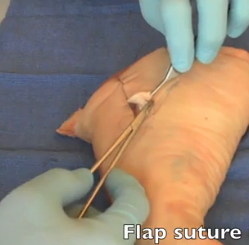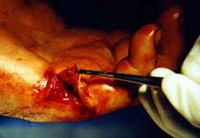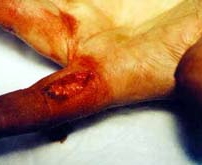Under Construction 
   Suturing Video Flap Laceration Avulsion laceration
Suturing Video Flap Laceration Avulsion laceration
Avulsion - An injury resulting in detachment, from a piece of skin to a complete body part. Most avulsions require skin grafts or reconstructive surgery.
Technically an avulsion is different than a laceration or abrasion, but is sometimes listed as a sub-category of each.
- Apply direct pressure with clean gauze or cloth over the site. Five or ten minutes with no peaking, which can cause more bleeding.
Add additional gauze if necessary, do not remove the first layer.
- Saline or tap water may be used for wound irrigation, whereas povidone-iodine, detergents, and hydrogen peroxide should be avoided.
- The sting from a local anesthetic injection can be decreased by slow administration and buffering the solution.
- Suturing is the preferred technique for skin laceration repair.
- Tissue adhesives are comparable with sutures in cosmetic results, dehiscence rates, and infection risk.
- Do not close a laceration if there is visible contamination, debris, non-viable tissue or signs of infection.
- Applying white petrolatum to a sterile wound to promote wound healing is as effective as applying an antibiotic ointment.
Some people carry a curved needle and dental floss for emergency suturing.
Links:
Treating small cuts and scrapes here
Pictures of Lacerations @ SurviveOutdoors.com
Skin Flaps @ UtahMountainBiking.com
Head lacerations. | Bandaging the wound @ heal-h.ru
Video: How to Tie a Head Wrap | eHow.com
How to Suture a wound with a skin flap closed | First Aid @ WonderHowTo.com
Return to Emergency
last updated 14 Oct 20012
|
